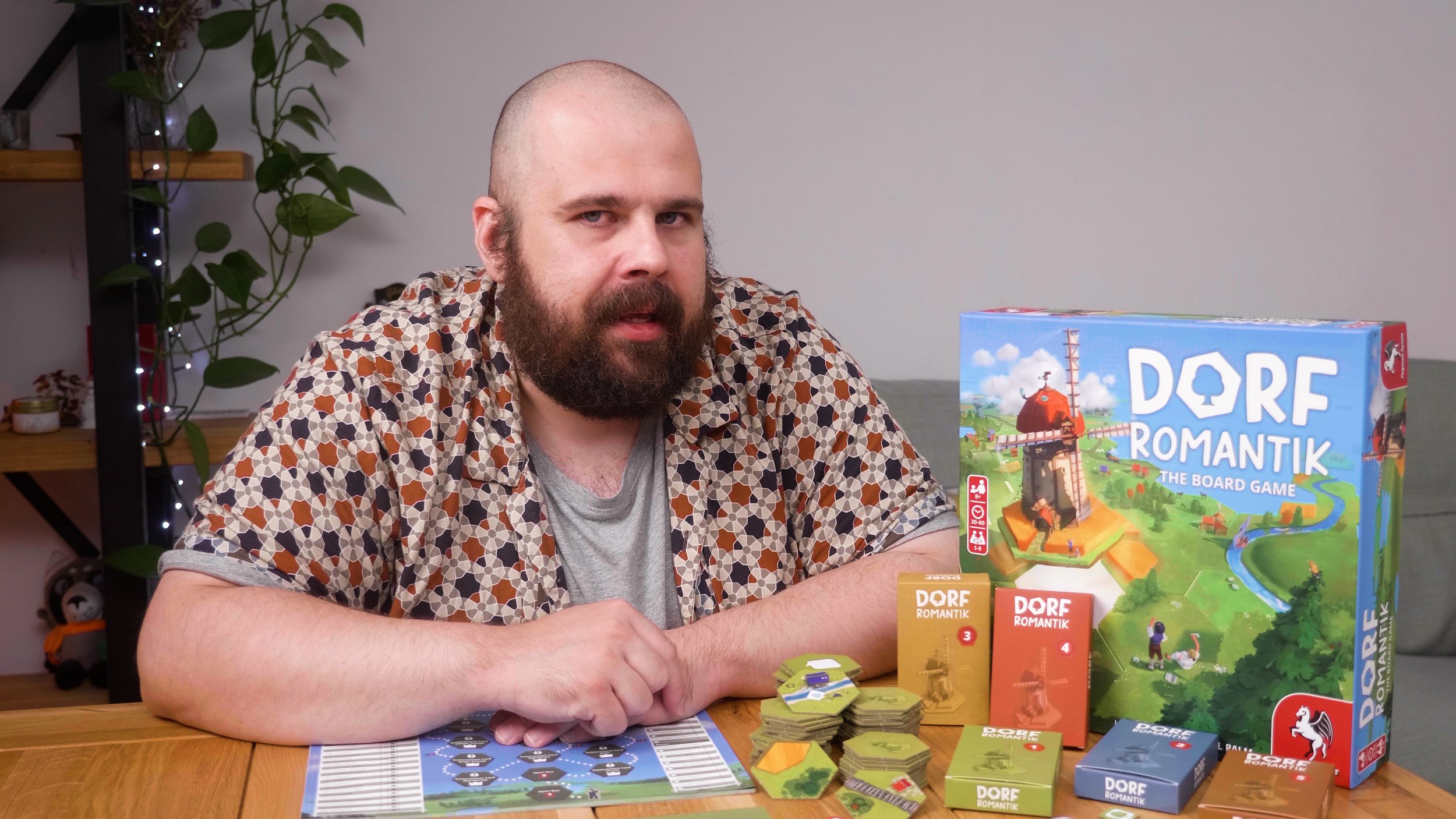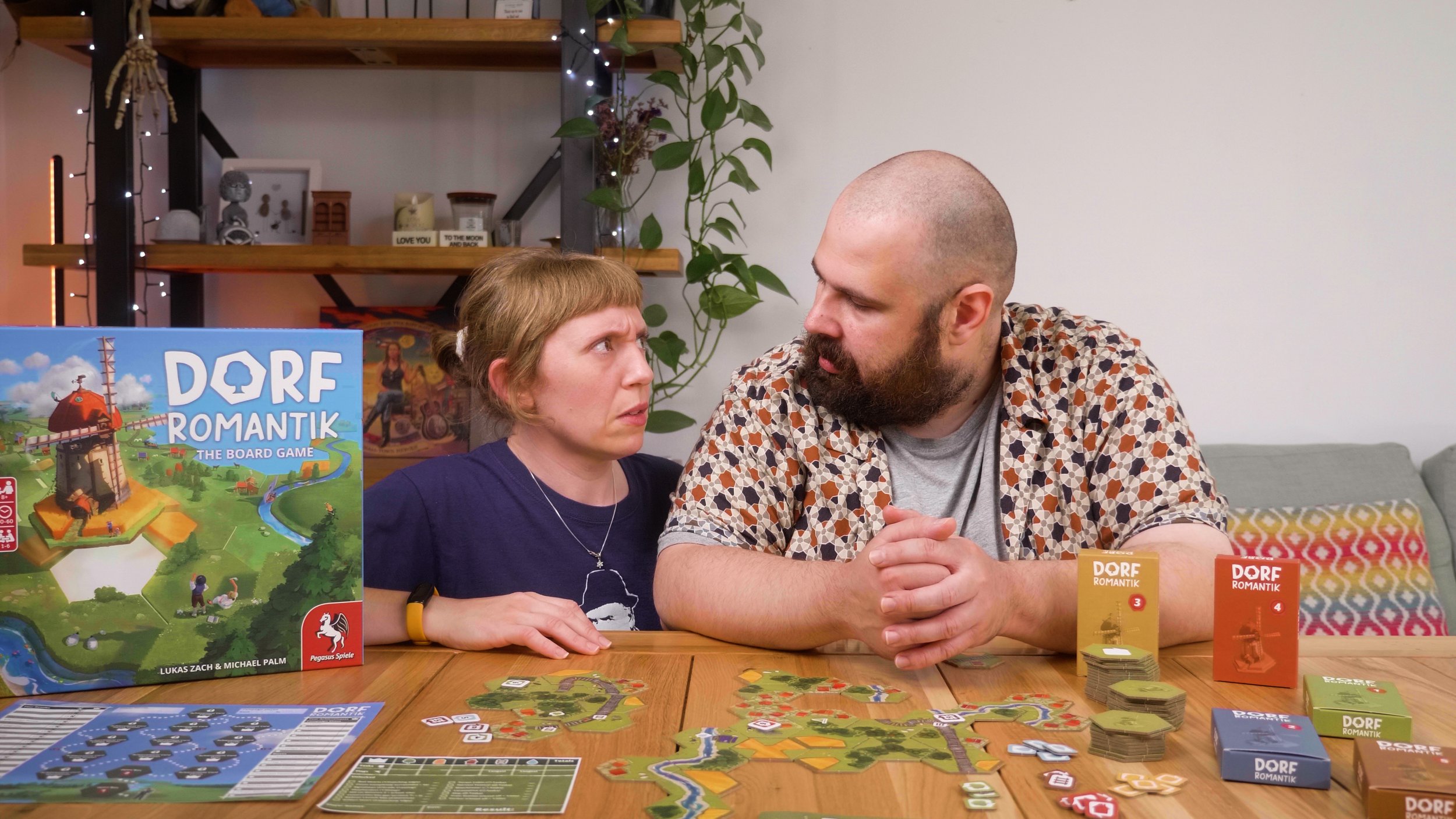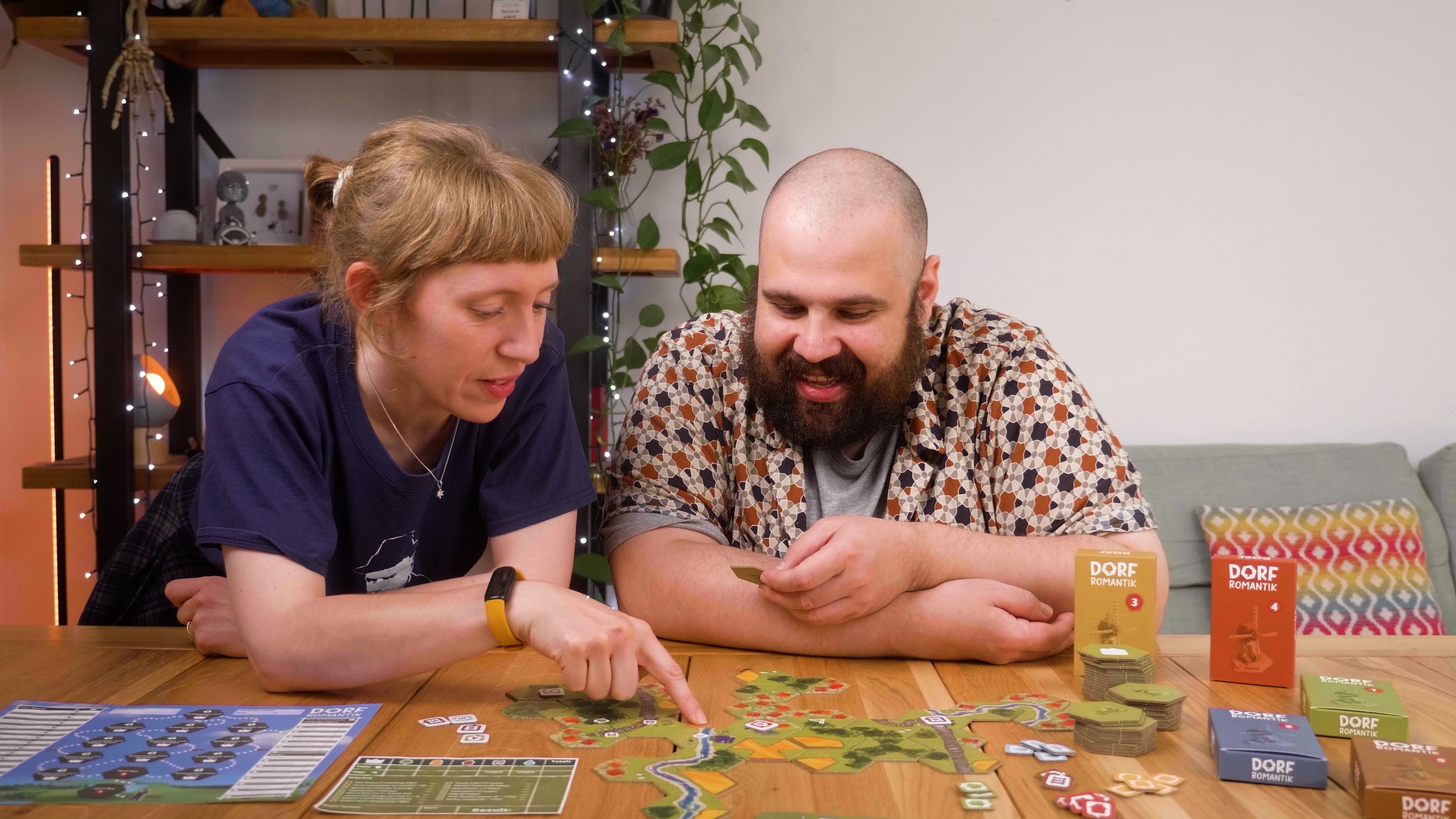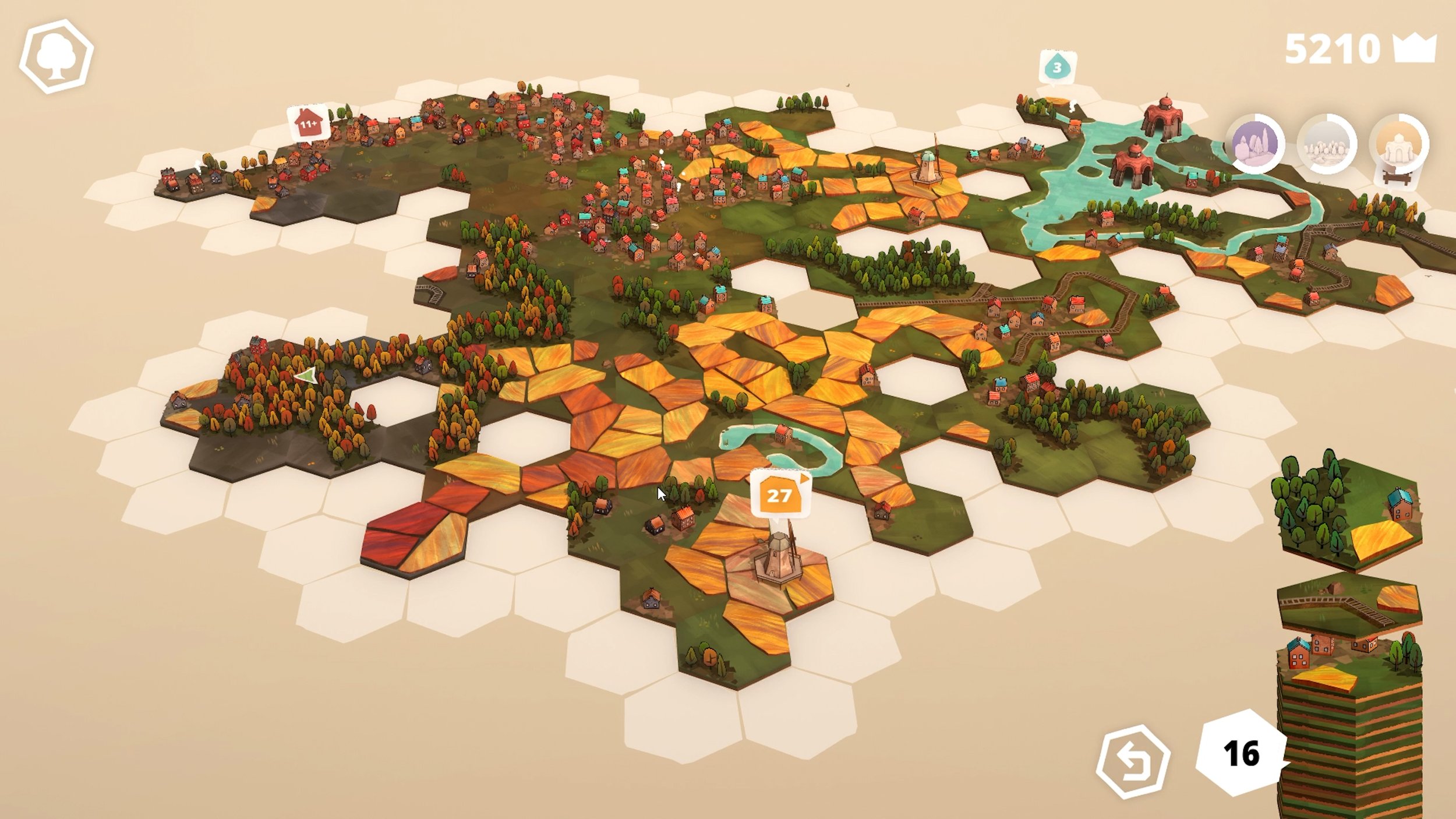The Unlosable Game - Dorfromantik the Board Game
Just when you think the well of tile laying games like Carcassone is exhausted, here comes Dorfromantik to say, “what if we change it up just a little?” And turns out changing it up just a little means winning the coveted Spiel des Jahres award for 2023 - phoah! That’s a prize if there was one.
So what’s the change? Well, dorfromantik removes the possibility of losing, and I imagine when I say that you have more questions than excitement. How in the world does it work? How is it fun? Well, that’s what our review is for.
You can watch the video here and read the transcript below.
Dear friend, have you heard the good word of placing a tile? Would you like to sip from the fount of hexagonal delights? Are you familiar with the sumptuous relish of making a landscape that looks like a map that you built yourself by following an eight page rules manual? Then let me seduce you with a little gem called dorfromantik. That’s just… that’s a cool name.
[Efka] You might be asking me,
[Elaine] How do you dorf?
[Efka] Let me show you. Each turn in dorfromantik you take a tile off a pile and place it anywhere you like.
[Elaine] Does it have to match other tiles?
[Efka] No, unless it’s a river or a railroad, those have to match, anything else is fine as long as it’s adjacent, no double dorfing.
[Elaine] How do you win?
[Efka] You always win.
[Elaine] WHAT? Yeah just place the last tile, the game’s over, count up your score – you’ve won.
[Elaine; long pause, taps fingers on the table] Where is the game?
[Efka] That is an excellent question.
So dorfromantik is a pretty cool game, but to explain why, I’m gonna have to get a little game design nerdy, so bear with me. If you enjoy simple elegant games, I think you’re going to have a great time with this despite it bucking every conventional game sensibility, and if you like complex meaty games – I think there’s actually something to learn here.
Every game relies on tension residing in players, and that tension is usually expressed with the question CAN I WIN.
In competitive games you ask this question in relation to the other players. Can I win against Colin? Probably. Maybe? Dunno, Colin can surprise you.
In co-operative games, like dorfromantik you ask this question together with the other players. Can we fight the system? Can we beat the clock? Reach the threshold? Here’s the thing, in dorfromantik the answer to all these is yes, before you even begin playing. And yet, it’s still surprisingly tense. How does it achieve that? It simply expects you to play it more than once.
Like I mentioned, all you do on any given turn is draw a tile and choose where to place it. But at any given time, there are three special tiles on the board.
These look like any tile in the game but additionally they feature a quest. For example, this tile says build a forest extending from this tile that is exactly five tiles big. So if I have this quest, and I draw a tile with a forest, I can place it in such a way that it extends that forest, and as soon as that forest encompasses five tiles, I take the quest marker off and place it in my score pile. I now have five points!
Once this is done, I’ll draw a new tile from the special quest tile pile, and it’ll be a new quest. It’s a village quest! Then I draw a number tile from here, it has a six on it, now I need to work on a village that’s six tiles big.
And you’ll notice, there’s already tricksy things you can achieve. If you’ve been drawing village tiles before but had no village quest, you can still build up an area that’s say, four village tiles big, and then when you draw the village quest, bam, autocomplete, draw a new quest, we need a four tile long railroad bam, autocomplete, a field of six, got that ready, autocomplete – that feels very good, especially since it rewarded pre-planning.
There’s a few extra ways of increasing your score. The longest river and the longest railroad will score you one point for every tile in that river or railroad.
But wait, that’s already getting a bit tricky because if I have a river of seven I can’t put in this quest tile that needs a river of six, I have to start a new river which is now competing with my one longest river oh no what do I do?
And there’s also these flag tiles for forests fields and villages, they’ll also score you one point per tile in those forests fields and villages as long as that area is completely surrounded by other features at the end of the game.
This once again pulls you away from making many little scoring areas and asks you to work on a big one, with the added tension of not going full hubris and never closing it off before the stack runs out. Ugh, I want to place more, but I also need to finish it, and not place more. I’m gonna place more.
At which point you might be asking? Well, what’s the point of points if I win anyway? The simple answer is you’re trying to beat your previous score. But I won’t blame you if you think that’s too milquetoast or not particularly interesting, but hang in there, we’re getting to the actual point.
Let me tell you how our very first game of dorfromantik went. And let me start by saying, it’s just a surprisingly lovely time?
There was something intimately collaborative about drawing a tile, and together figuring out how you expand this landscape. I did say the game is tense, but not tense in a way where much is riding on any one given placement. It’s chill tension basically. Is that a thing? It is now!
So turn to turn you discuss, you collaborate, investigate this map you’ve conjured. How about here, oh I dunno do we really need to expand this forest? Oh wait, wait, look, it fits perfectly here! Yeah it scores zero points tho why would you put it here?
Cause it’s pleasing, and that’s valid. Anyway, we talked, we laughed we ached, the tiles were dwindling and with that stack getting oh so tiny finishing up the last objectives felt very important. Are there even any railroads left? We just need one more!
And then it’s over. We looked at our score pile. We literally cleared every quest tile available in the game. Amazing! Our score must be really good. We could have maybe made our roads and railroads a little longer, opportunities to improve but overall we’re champs. Right?
Ahem. So, there’s this campaign sheet that gives you a score chart. We accumulated a 147 points. And then looked at this and it told us that a possible high score is 400. Whoops.
This was my first clue that there’s just way more going on than I initially gave this credit for. In fact, I don’t even think you could get 400 points from just these initial starting rules. But that’s the thing, once you finish, the game is far from over.
I don’t wanna call this a campaign game, it’s a weird label that gives all kinds of expectations, like having to get the same people together all the time or keep playing it past the point where you want to, or remember all the rules that you’ve unlocked. No no no, nothing like that.
But you do unlock things. Each time you finish a game you check your score. That’ll tell you how many pips you’ve earned, which you can the color into this track. This will lead you to various things you can unlock, and yes there are boxes you open, but they’re not like these massive surprises that are gonna wow you – they are just more different things you can and try and explore.
Achievements that say, hey do this, unlock a new thing. Can you, gonna make something up, dunno if it’s actually in the game, create a long river that loops back onto itself? In the space of one game? Whilst juggling all the other things?
So when I said you win every game by default, I was sort of lying. You do win, but you actually only feel like you’ve won if you achieved the task you set out to do at the very beginning. In that sense it’s almost like you pick your own objective, your own quest. What sounds fun to you? Do that! Can you do two things? Three?
And also, you want to beat your previous score. Which on our second game we totally failed by scoring 146 points – that’s one measly point lower for those keeping track.
And that’s the appeal of dorfromantik, sit down by yourself, or with someone who’s company you enjoy, and have another go. I wouldn’t play this with strangers at like a club or whatever, but it’s perfect for couples or good friends. It’s moreish, relaxed, and it’s got that tile laying goodness. Every game is a little different and offers a new thing to take on. It’s nice.
Some of you might also recognise dorfromantik in its video game form which was how it originally appeared in the world at the height of lockdowns and then sort of petered away like most pandemic things, you know, like sourdough bread, or the sensation that one day everything is going to be fine.
(Weird disclosure time, this is not a review copy. We bought this game. But the video game maker did originally send us a code for the video game back when it came out, so there’s that.)
I actually wasn’t really that excited for dorfromantik the board game, I liked the video game but then just sort of forgot that it exists. But I think this is actually the form this game really works in. Playing with two is just great, and seeing the whole thing you’ve built at all times and planning new placements with a bird’s eye view feels much better than scrolling around an lcd screen of rampant tile growth.
The rules, whilst being nearly identical feel more contained and cohesive – I think this game is in its perfect form. It might be “not for everyone” but I don’t think I’ll stop thinking about dorfromantik the board game. I’ll always want to dorf it just one more time.









